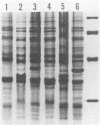Abstract
The pathogenic properties of 16 Plesiomonas shigelloides strains recovered from humans with extraintestinal and intestinal illnesses, infected animals, and environmental sources were investigated. Most strains possessed a high cell charge and low surface hydrophobicity analogous to those of Shigella spp.; additionally, serogroup O:17 strains reacted with Shigella group D antisera. However, unlike the shigellae, P. shigelloides strains did not universally bind Congo red, were noninvasive in HEp-2 cell assays, and did not produce a Shiga-like toxin on Vero cells. On HEp-2, Y1, and possibly Vero cells, a low-level cytolysin was consistently produced by all 16 P. shigelloides strains when grown in either Evan Casamino Acids-yeast extract or Penassay broth. The median 50% lethal dose for all 16 P. shigelloides strains in outbred Swiss Webster mice was 3.5 x 10(8) CFU (range, 3.2 x 10(7) to greater than 1 x 10(9) CFU). Animal pathogenicity did not correlate with cytolysin expression, possession of a greater than or equal to 120-MDa plasmid, protein profile, or resistance to complement-mediated lysis. No strain analyzed produced siderophores or a heat-stable enterotoxin. The results suggest that members of the genus Plesiomonas have an overall low pathogenic potential, irrespective of the site of isolation or phenotypic, serologic, or surface properties shared with other traditional enteropathogens.
Full text
PDF
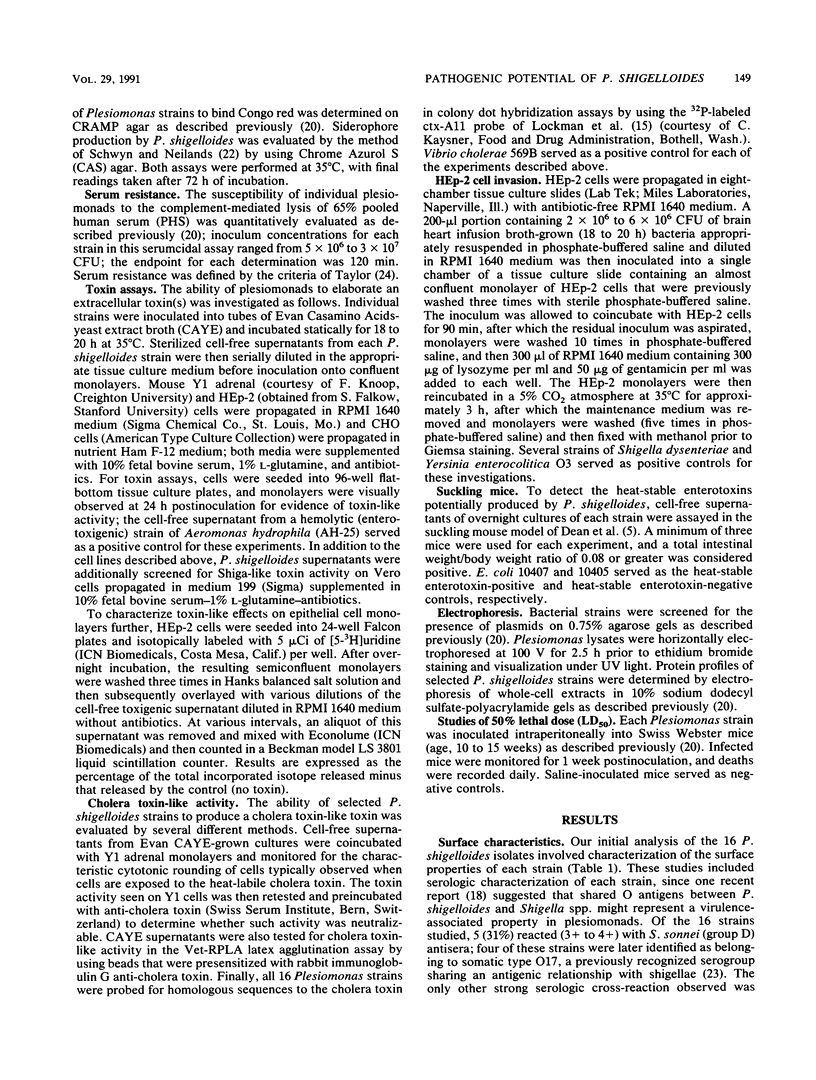
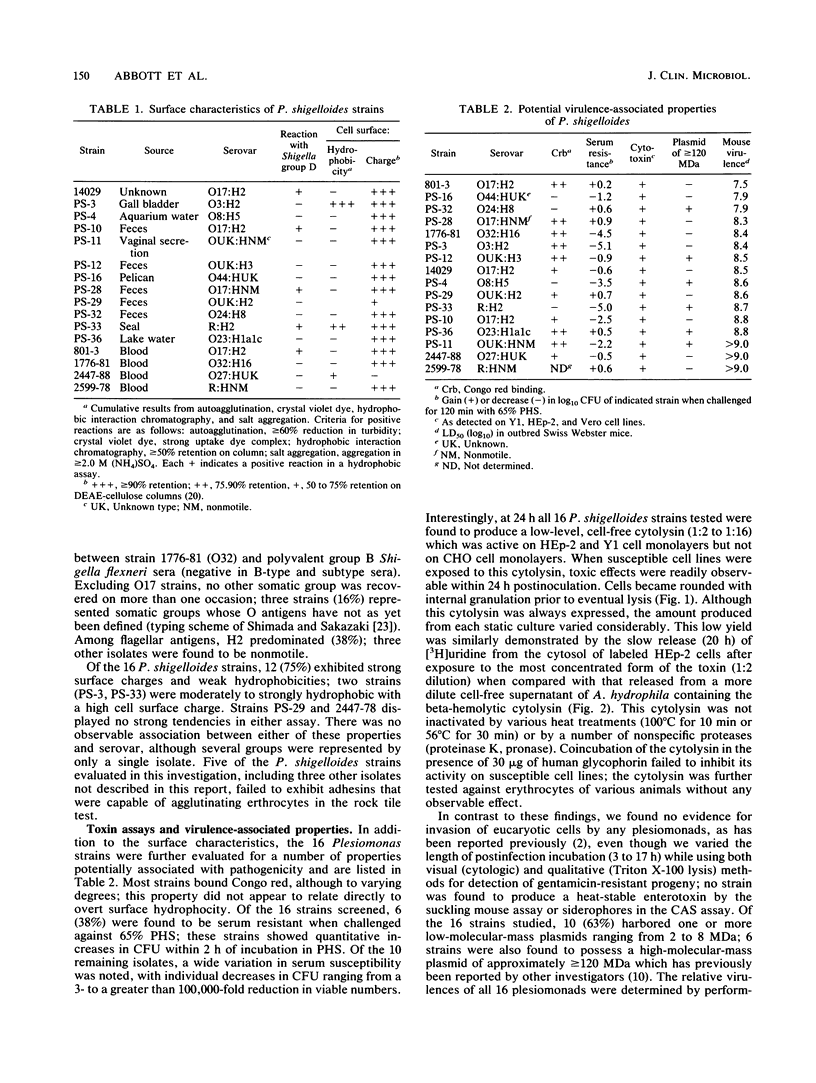
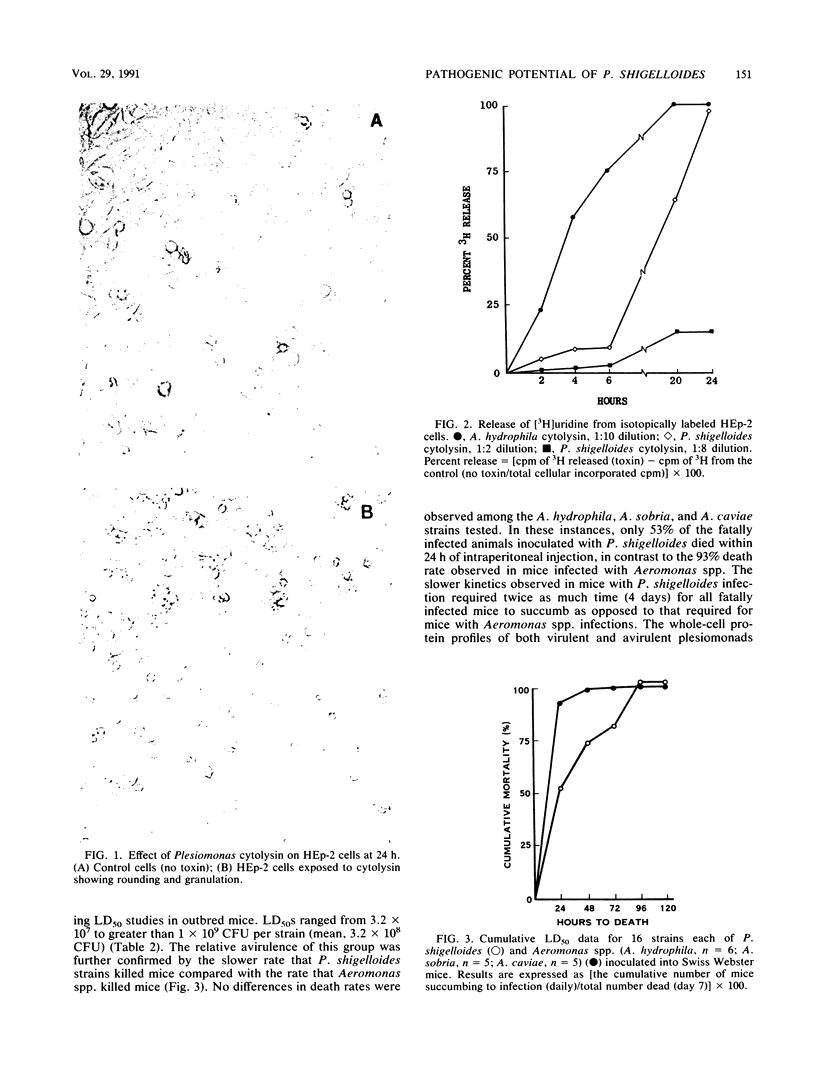
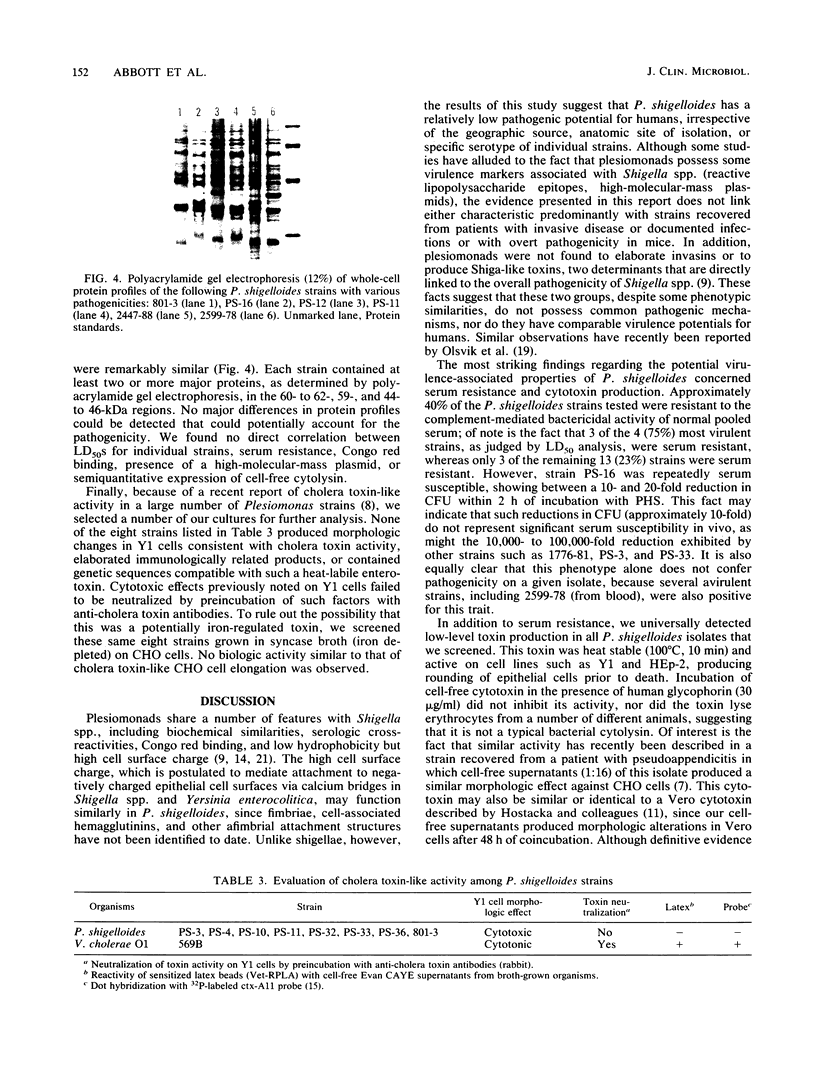
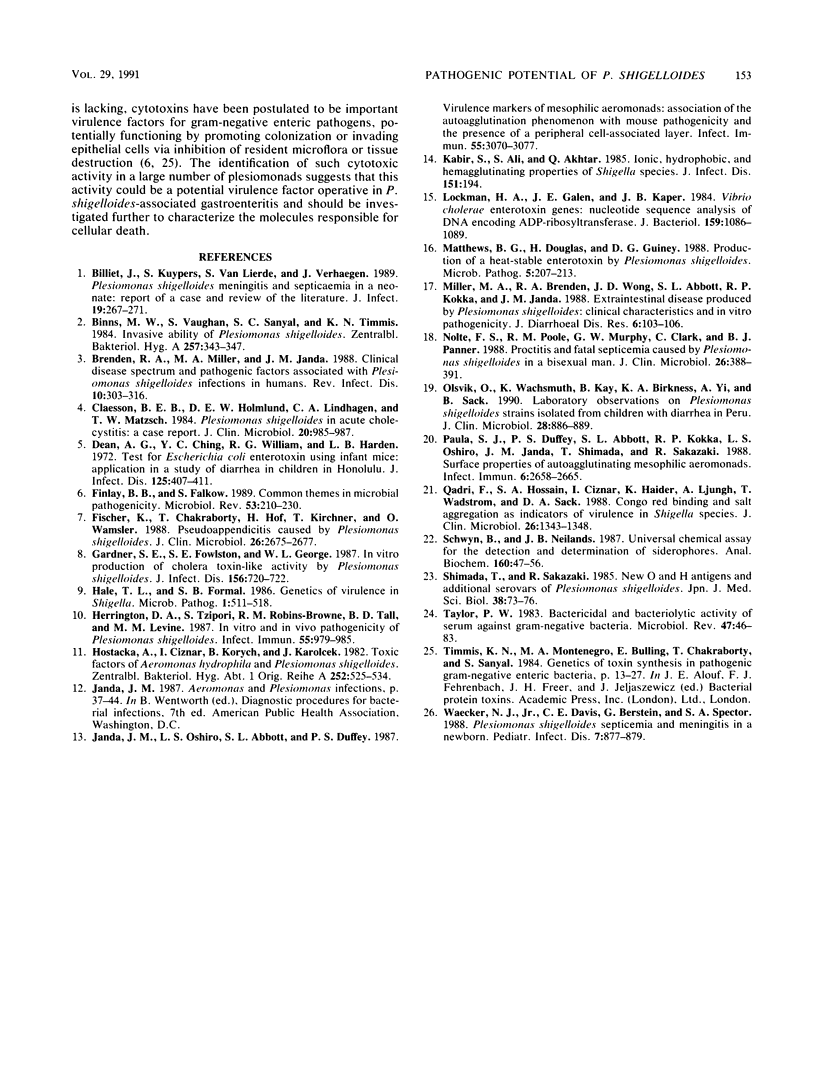
Images in this article
Selected References
These references are in PubMed. This may not be the complete list of references from this article.
- Billiet J., Kuypers S., Van Lierde S., Verhaegen J. Plesiomonas shigelloides meningitis and septicaemia in a neonate: report of a case and review of the literature. J Infect. 1989 Nov;19(3):267–271. doi: 10.1016/s0163-4453(89)90809-8. [DOI] [PubMed] [Google Scholar]
- Binns M. M., Vaughan S., Sanyal S. C., Timmis K. N. Invasive ability of Plesiomonas shigelloides. Zentralbl Bakteriol Mikrobiol Hyg A. 1984 Aug;257(3):343–347. [PubMed] [Google Scholar]
- Brenden R. A., Miller M. A., Janda J. M. Clinical disease spectrum and pathogenic factors associated with Plesiomonas shigelloides infections in humans. Rev Infect Dis. 1988 Mar-Apr;10(2):303–316. doi: 10.1093/clinids/10.2.303. [DOI] [PubMed] [Google Scholar]
- Claesson B. E., Holmlund D. E., Lindhagen C. A., Mätzsch T. W. Plesiomonas shigelloides in acute cholecystitis: a case report. J Clin Microbiol. 1984 Nov;20(5):985–987. doi: 10.1128/jcm.20.5.985-987.1984. [DOI] [PMC free article] [PubMed] [Google Scholar]
- Dean A. G., Ching Y. C., Williams R. G., Harden L. B. Test for Escherichia coli enterotoxin using infant mice: application in a study of diarrhea in children in Honolulu. J Infect Dis. 1972 Apr;125(4):407–411. doi: 10.1093/infdis/125.4.407. [DOI] [PubMed] [Google Scholar]
- Finlay B. B., Falkow S. Common themes in microbial pathogenicity. Microbiol Rev. 1989 Jun;53(2):210–230. doi: 10.1128/mr.53.2.210-230.1989. [DOI] [PMC free article] [PubMed] [Google Scholar]
- Fischer K., Chakraborty T., Hof H., Kirchner T., Wamsler O. Pseudoappendicitis caused by Plesiomonas shigelloides. J Clin Microbiol. 1988 Dec;26(12):2675–2677. doi: 10.1128/jcm.26.12.2675-2677.1988. [DOI] [PMC free article] [PubMed] [Google Scholar]
- Gardner S. E., Fowlston S. E., George W. L. In vitro production of cholera toxin-like activity by Plesiomonas shigelloides. J Infect Dis. 1987 Nov;156(5):720–722. doi: 10.1093/infdis/156.5.720. [DOI] [PubMed] [Google Scholar]
- Hale T. L., Formal S. B. Genetics of virulence in Shigella. Microb Pathog. 1986 Dec;1(6):511–518. doi: 10.1016/0882-4010(86)90037-9. [DOI] [PubMed] [Google Scholar]
- Herrington D. A., Tzipori S., Robins-Browne R. M., Tall B. D., Levine M. M. In vitro and in vivo pathogenicity of Plesiomonas shigelloides. Infect Immun. 1987 Apr;55(4):979–985. doi: 10.1128/iai.55.4.979-985.1987. [DOI] [PMC free article] [PubMed] [Google Scholar]
- Hostacká A., Ciznár I., Korych B., Karolcek J. Toxic factors of Aeromonas hydrophila and Plesiomonas shigelloides. Zentralbl Bakteriol Mikrobiol Hyg A. 1982 Sep;252(4):525–534. [PubMed] [Google Scholar]
- Janda J. M., Oshiro L. S., Abbott S. L., Duffey P. S. Virulence markers of mesophilic aeromonads: association of the autoagglutination phenomenon with mouse pathogenicity and the presence of a peripheral cell-associated layer. Infect Immun. 1987 Dec;55(12):3070–3077. doi: 10.1128/iai.55.12.3070-3077.1987. [DOI] [PMC free article] [PubMed] [Google Scholar]
- Kabir S., Ali S., Akhtar Q. Ionic, hydrophobic, and hemagglutinating properties of Shigella species. J Infect Dis. 1985 Jan;151(1):194–194. doi: 10.1093/infdis/151.1.194. [DOI] [PubMed] [Google Scholar]
- Lockman H. A., Galen J. E., Kaper J. B. Vibrio cholerae enterotoxin genes: nucleotide sequence analysis of DNA encoding ADP-ribosyltransferase. J Bacteriol. 1984 Sep;159(3):1086–1089. doi: 10.1128/jb.159.3.1086-1089.1984. [DOI] [PMC free article] [PubMed] [Google Scholar]
- Matthews B. G., Douglas H., Guiney D. G. Production of a heat stable enterotoxin by Plesiomonas shigelloides. Microb Pathog. 1988 Sep;5(3):207–213. doi: 10.1016/0882-4010(88)90023-x. [DOI] [PubMed] [Google Scholar]
- Miller M. A., Brenden R. A., Wong J. D., Abbott S. L., Kokka R. P., Janda J. M. Extraintestinal disease produced by Plesiomonas shigelloides: clinical characteristics and in vitro pathogenicity. J Diarrhoeal Dis Res. 1988 Jun;6(2):103–106. [PubMed] [Google Scholar]
- Nolte F. S., Poole R. M., Murphy G. W., Clark C., Panner B. J. Proctitis and fatal septicemia caused by Plesiomonas shigelloides in a bisexual man. J Clin Microbiol. 1988 Feb;26(2):388–391. doi: 10.1128/jcm.26.2.388-391.1988. [DOI] [PMC free article] [PubMed] [Google Scholar]
- Olsvik O., Wachsmuth K., Kay B., Birkness K. A., Yi A., Sack B. Laboratory observations on Plesiomonas shigelloides strains isolated from children with diarrhea in Peru. J Clin Microbiol. 1990 May;28(5):886–889. doi: 10.1128/jcm.28.5.886-889.1990. [DOI] [PMC free article] [PubMed] [Google Scholar]
- Paula S. J., Duffey P. S., Abbott S. L., Kokka R. P., Oshiro L. S., Janda J. M., Shimada T., Sakazaki R. Surface properties of autoagglutinating mesophilic aeromonads. Infect Immun. 1988 Oct;56(10):2658–2665. doi: 10.1128/iai.56.10.2658-2665.1988. [DOI] [PMC free article] [PubMed] [Google Scholar]
- Qadri F., Hossain S. A., Ciznár I., Haider K., Ljungh A., Wadstrom T., Sack D. A. Congo red binding and salt aggregation as indicators of virulence in Shigella species. J Clin Microbiol. 1988 Jul;26(7):1343–1348. doi: 10.1128/jcm.26.7.1343-1348.1988. [DOI] [PMC free article] [PubMed] [Google Scholar]
- Schwyn B., Neilands J. B. Universal chemical assay for the detection and determination of siderophores. Anal Biochem. 1987 Jan;160(1):47–56. doi: 10.1016/0003-2697(87)90612-9. [DOI] [PubMed] [Google Scholar]
- Shimada T., Sakazaki R. New O and H antigens and additional serovars of Plesiomonas shigelloides. Jpn J Med Sci Biol. 1985 Apr;38(2):73–76. doi: 10.7883/yoken1952.38.73. [DOI] [PubMed] [Google Scholar]
- Taylor P. W. Bactericidal and bacteriolytic activity of serum against gram-negative bacteria. Microbiol Rev. 1983 Mar;47(1):46–83. doi: 10.1128/mr.47.1.46-83.1983. [DOI] [PMC free article] [PubMed] [Google Scholar]
- Waecker N. J., Davis C. E., Bernstein G., Spector S. A. Plesiomonas shigelloides septicemia and meningitis in a newborn. Pediatr Infect Dis J. 1988 Dec;7(12):877–879. [PubMed] [Google Scholar]




